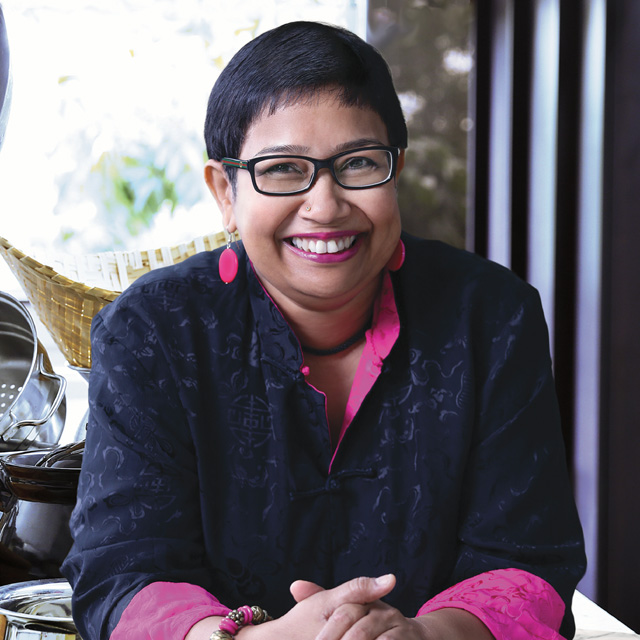As she opens the door to her kitchen, Chef Devagi smiles and you can hear her whisper, “good morning”, “hello” and on some days, it’s a smile and nod. She greets her kitchen and her kitchen appliances each morning, and thanks them at the end of the day. “I have been doing this since I got married and moved into my own house. Aatha (grandmother) once told me that the kitchen and its appliances are alive, and this ritual of gratitude acknowledges their role in our lives,” explains the Spice Queen of Singapore. Returning home from the ASEAN conference ‘Spice: The Connecting Culture of Southeast Asians’ which took place in in Jogyakarta, Indonesia, she says she was glad to be around experts and culinary enthusiasts who shared her love for spices.
Conversations with Chef Devagi, clearly reveal the influence her aatha (grandmother), amma (mother) and periyamma (aunt) have had on her culinary journey. Her grandmother, named Nagammal was born in Dili, Timor-Leste (Indonesia) and brought to Singapore by her parents when she was about three years old. Though originally from Kumbakonam, her family, like many other Indians moved to Indonesia in search of better opportunities back then.
“Aatha lived in a large house on her own land, complete with a small vegetable garden. The house featured a spacious kitchen with three to four sub-kitchens used by paying tenants. Her kitchen was never organized in a conventional sense. At the entrance, there was a small shelf for placing deities and performing daily prayers and rituals. I remember her praying before entering the kitchen,” she recounts.
Chef Devagi has vivid memories of her grandmother making pickles and vadagams (rice, lentil or vegetable crackers) frequently. “During the hot month of May in Singapore, she would sun-dry Mor Milagai and sometimes make spicy Arisi Vadagams (rice crackers), which she pressed out using a ‘ribbon murukku’ disc of a murukku acchhu. Her specialties were Elumichai Pazham (lemon) Maangai (mango) pickles, and she often made Malay-style Mixed Vegetable Achaar” she says. The Malaysian style pickles were also prepared during Deepavali or when they were serving biryani or Nei Choru (ghee rice). “To make it, aatha would sun-dry cucumber, carrot, shallots, chilies, and pineapple slices for a whole day to remove as much water content as possible, ensuring the achaar turned out well”.
“Traditional drying techniques have several advantages; for example, they do not rely on electricity, making them accessible and eco-friendly. Additionally, there are no artificial additives involved, ensuring the food remains wholesome and natural,” explains the Chef who is working on her next two books. The first is titled, ‘Amma’s Legacy’ which is a memoir and recipe book with stories of the three important women in her life, and the food they cooked and served The second is titled ‘The Singapore Indian Cookbook’ which would be a collection of recipes from the Indians who migrated to Singapore and how many of the dishes have been modified with local ingredients like soy sauce, tofu, and coconut sugar.
Chef Devagi recalls the delicious meals her aatha cooked and her vast collection of brass kitchenware that were handed down to her mother, and then eventually donated to the National Museum of Singapore. “Though she never owned a refrigerator, she bought the freshest meats and seafood as needed and the vegetables were either from her garden or purchased and stored in a large rattan basket in the kitchen,” explains the Spice Queen who has been spending a lot of time in India cooking, travelling and researching on traditional Indian food.
I ask, how different is her kitchen? “My kitchen is the opposite of Aathas! It is bright, with tiled floors and walls, and plenty of storage in the built-in kitchen cabinets. Ingredients are stored in glass containers and metal tins. Instead of traditional grinding implements, I use many electrical kitchen appliances. I own over 18 high-quality knives! Additionally, I have a small statue of Goddess Annapoorni in the kitchen,” she concludes.
Malay Style Mixed Vegetable Achaar
Ingredients
500 g cucumber, deseeded and cut into sticks
350 g carrot, cut into sticks
300 g pineapple, cut into sticks or diced
30 g red chillies, chopped coarsely
30 g red chilli padi (peppers), sliced
150 g onion, diced
80 g sugar
5 g salt
100 ml white vinegar
2 tablespoons cooking oil
5 g mustard seeds
2 sprigs curry leaves
METHOD
- Prepare the vegetables.
- Lay them on a clean cloth and sun-dry them for about 5-7 hours. Sun drying concentrates the flavour and makes the vegetables crunchy when pickled.
- Heat oil and fry the mustard seeds and curry leaves.
- Add sugar, salt, and vinegar. Bring to a boil, then turn off the stove.
- Add turmeric powder, stir, and then add the sun-dried vegetables.
- Stir well to mix, then leave aside in a non-reactive bowl for about 3-4 hours. The pickles are now ready to be served.

To know more about Chef Devagi Sanmugam’s culinary trails log onto https://devagisanmugam.com/

